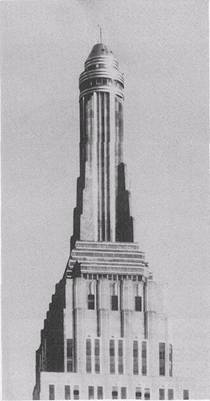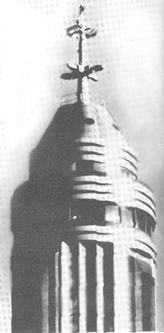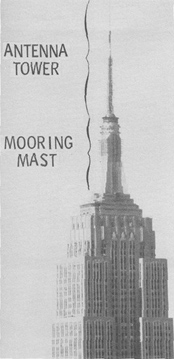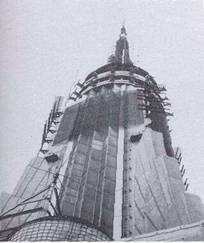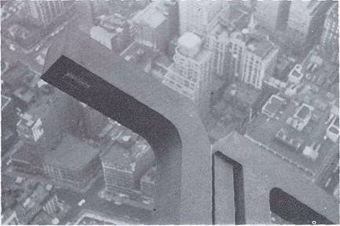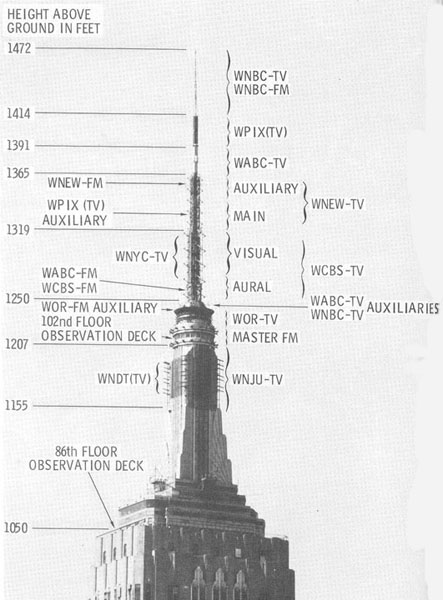|
1967 Facilities
Today the Empire Slate
Building occupies a unique position in the broadcast industry. It furnishes
leased vertical space of 317 feet for the antennas of 22 stations. Between the
80th and 85th floors arc housed 35 separate broadcast transmitters with a
combined total RF output power of over 400 KW. The Empire state Building Co.
owns the master FM antenna and leases it to individual FM stations —
perhaps the only such situation in the world. The company also has
responsibility for general maintenance of the TV lower.
The tower is provided with
a code beacon, and there is obstruction lighting at three lower levels. The
mooring-mast section of the building is illuminated by flood-lights. FCC rules
with respect to tower painting are waived in favor of tower lighting 24 hours
per day.
Stations currently
transmitting from the building are listed below in order of their position from
the top of the tower (Fig. 6).
WNBC-TV (ch. 4): 25.7 KW
visual, 5.13 KW aural at 1445 ft. WNBC (FM) (97.1 MHz): 1.1 KW at 1445 ft. WNBC
visual, aural, and FM signals are triplexed into a single 4-bay superturnstile
antenna 56 ft in length.
WPIX (TV) (ch.11): 100 KW visual, 20 KW aural at 1400 ft, using a
zigzag antenna 23 ft in length. (Also auxiliary antenna at 1325 ft
level.)
WABC-TV (ch. 7);110 KW
visual, II KW aural at 1380 ft. using a Z-type antenna 25 ft in
length.
WNEW-FM (102.7 MHz): 4.1 KW
horizontal, 4.1 KW vertical at 1360 ft, A special single-bay antenna is used.
It consists of 4 horizontal dipoles on the tower faces, and 4 vertical dipoles
on the corners. All dipoles are positioned between the upper two bays of the
WNEW-TV array.
WNEW-TV (ch. 5): 37.1 KW
visual, 5.5 KW aural at 1330 ft, A five-bay antenna 56 ft in length is
employed. The upper two bays are used as an auxiliary antenna, while the lower
three bays are used as the main antenna,
WPIX (TV): This station
also has a main antenna at 1400 ft.
WCBS-TV (ch. 2); 42 KW
visual, 8.32 KW aural at 1300 ft. A five-bay antenna 65 ft in length is used.
The upper three bays are for visual, and the lower two bays for aural
transmission.
WNYC-TV (ch. 31); 890 KW
visual, 89 KW aural at 1290 ft. A special antenna, utilizing vertical slots in
a collinear traveling wave array 40 ft in length is in service. There are 24
slots, or bays, in each element.
WABC-FM (95.5 MHz); 1.5 KW
at 1270 ft., (101.1 MHz): 1.5 KW at 1270 ft,
WABC-FM and WCBS-FM are
duplexed into a single-bay antenna consisting of four horizontal dipoles
mounted on the tower faces between the two lower bays of the WCBS-TV
array.
WABC-TV and WNBC-TV: These
stations have auxiliary antennas at the 1250-ft level (the very top of the
mooring mast).
WOR-FM: An auxiliary
antenna is located just below the base of the TV tower.
WOR-TV(ch. 9): 155 KW
visual, 31 KW aural at 1240 ft. A special 2-bay antenna 8 ft in length is in
use. Each bay consists of 24 dipoles equally spaced around the top of the
mooring mast, approximately 35 ft in diameter.
Master FM Antenna: Each of
the two bays consists of 16 dipoles equally spaced around the mooring mast
above and below the 102nd-floor observation deck. Height is 1220 ft. Stations
now using the array:
WBAI (FM) (99.5 MHz): 5.4
KW horizontal, 3.8 KW vertical
WHOM (FM) (92.3 MHz): 5.4
KW horizontal, 3.8 KW vertical
WLIB (FM) (107.5 MHz): 2.0
KW horizontal, 1.45 KW vertical
WNCN (FM) (104.3 MHz): 5.4
KW 3.5 KW vertical
WNYC (FM) (93.9 MHz); 5.3
KW horizontal, 3.7 KW vertical
WOR (FM) (98.7 MHz): 5.4 KW
horizontal, 3.8 KW vertical
WPIX (FM) (101.9 MHz): 5.4
KW horizontal. 3.8 KW vertical
WQXR (FM) (96.3 MHz): 5.4
KW horizontal. 3,8 KW vertical
WRFM (FM) (105.1 MHz): 5.2
KW horizontal, 3.7 KW vertical
WNDT (TV) (ch. 13): 178 KW
visual, 34.7 KW aural at 1180 ft. A stacked 6-bay Yagi, 27.5 ft in length, is
employed.
WNJU-TV (ch. 47): 234 KW
visual, 46.8 KW aural at 1180 ft. In use is a special 4-bay vertical-slot
antenna 52 ft in length. The antenna consists of two sections which are mounted
on the north and south faces of the mooring mast.
The
Future
Some time ago, a
feasibility study was conducted by a consulting engineering firm for the Empire
State Building Co. This study showed that the mooring mast could hold several
more UHF antennas. Currently a CP is held by WTVE (ch. 41). licensed to
Patterson, N. J., which proposes another antenna on the building. Another FM
station is considering using the master FM antenna. Also, WABC-FM, WCBS-FM. and
WNDT plan to install new antennas during the summer of 1967.
The world's most unusual
antenna site may not exist much longer. Recently, the Port of New York
Authority has been planning the construction of twin 110-story skyscrapers in
Lower Manhattan. Independent studies by Alford Manufacturing Co, and Jansky and
Bailey have shown that the proposed towers would cause ghosting to some viewers
watching some of the TV stations presently on the Empire State Building.
Several solutions to the program have been advanced, one being to relocate
antennas from Empire State to the new. taller structures (to be known as the
World Trade Center).
Whatever the future of the
Empire State Building antenna site. it remains a monument to the ability of
broadcast engineers and stations to cooperate for their mutual welfare and for
the public benefit.
Acknowledgements
The author wishes to thank
the various engineers of the stations, networks, and companies mentioned for
their assistance in preparing this report. He is especially grateful to Thomas
J. Buzalski of NBC. John F. Garrety of the Empire State Building Co., Dr. Frank
G, Kear of Kear and Kennedy, Harold H. Leach of Alford Manufacturing Co., and
Robert M. Morris, formerly of ABC and NBC.
...
August - 1967 |
